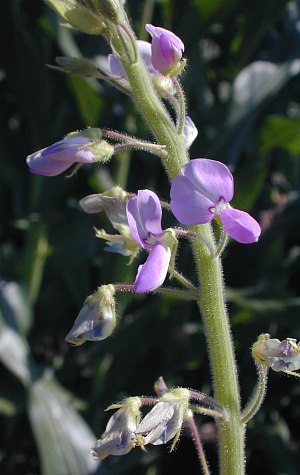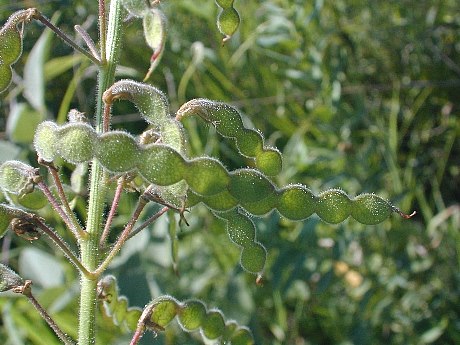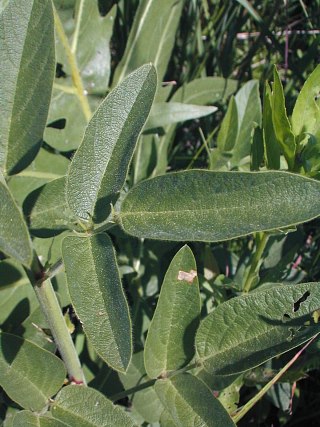Description: This herbaceous perennial plant is 2½–4' tall, branching sparingly. The stout central stem is round and covered with fine hooked hairs. The alternate compound leaves are trifoliate and have petioles about 1–2½" long. The leaflets are up to 3½" long and 1" across. A typical leaflet is lanceolate-oblong or lanceolate-ovate, with smooth margins, and a leathery texture. The base of a leaflet is rounded, while the tip is usually blunt. The lower surface is light or whitish green and has prominent veins; there are hooked hairs along the major veins. The central stem terminates in an elongated raceme of flowers about ½–1½' long. Usually, only a few flowers are in bloom at the same time.

Each
flower is about 1/3" (8 mm.) in length (up and down), and either pale
purple or
white. The two upper petals are larger than the others and
well-rounded; when these petals are pale purple, there is a small patch
of white near the throat of the flower, which is surrounded by a narrow
border of burgundy. There are also two side petals that enclose a lower
petal, which project outward. Together, they form a typical pea-shaped
flower. The hairy green calyx is divided into 5 lobes of unequal
length, while the pedicels of the flowers are slender and hairy. The
blooming period usually occurs during mid-summer and lasts about 3
weeks. There is no noticeable floral scent. The flowers are replaced by
flat seedpods about 1-3" long that are called 'loments.' These loments
have 3-9 segments that are well-rounded on both the upper and lower
sides. The surface of these loments are covered with hooked hairs that
can cling to clothing or fur. Individual segments of the loments can
break off and cling to more than one passing carrier. The root system
consists of a stout taproot. Vegetative colonies are not formed.
Cultivation:
The preference is full or partial sun, mesic conditions, and a fertile
loam or clay loam soil. This plant has good drought tolerance, and
it appears to have fewer problems with powdery mildew than some other Desmodium
spp., such as Desmodium canadense (Showy
Tick Trefoil). If it is grown in full sun, Illinois Tick Trefoil
remains quite erect because of its stout central stem. Its root system
adds nitrogen to the soil.

Range &
Habitat:
The native Illinois Tick Trefoil occurs occasionally in most counties
of central
and northern Illinois, but it is uncommon or absent in many areas of
southern Illinois (see Distribution
Map). Habitats include mesic to slightly dry black soil
prairies, sand prairies (less typical), oak savannas, scrubby barrens,
and areas along railroads and roadsides, especially where prairie
remnants occur. Usually, this species occurs as scattered plants, and
doesn't form the dense colonies of some Desmodium spp.,
such as Showy Tick Trefoil.
Faunal Associations:
The flowers attract long-tongued bees primarily, including bumblebees
and leaf-cutting bees (Megachile
spp.);
only pollen is available as a floral reward. Other insect feed on the
leaves, seeds, and other parts of Illinois Tick Trefoil and other tick
trefoils (Desmodium spp.).
These insects include the seed-eating larvae of Apion reconditum
and other
weevils; leaf-mining larvae of Pachyschelus laevigatus
(a metallic wood-boring
beetle); Colaspis
brunnea
(Grape Colaspis),
Odontota horni (Soybean Leafminer), and other leaf
beetles; larvae of Clinodiplosis
meibomiifoliae and other gall flies; Microparsus desmodiorum, Microparsus olivei, and other aphids; the seed-eating Megalotomus quinquespinosus (Lupine
Bug); leaf-eating larvae of Atomacera
debilis (an Argid sawfly); flower- and bud-eating larvae
of Grapholita fana
(Chesire Cat Moth) and larvae of other moths; larvae of Thorybes bathyllus
(Southern Cloudywing), Thorybes
pylades (Northern Cloudywing), and other skippers; larvae
of two butterflies, Everes
comyntas (Eastern Tailed Blue) and Strymon melinus
(Gray Hairstreak); and Neohydatothrips
desmodianus
(Tick Trefoil Thrips). The Insect Table
provides a more complete list
of these insects. Among vertebrate animals, the seeds of tick trefoils
are eaten by the Bobwhite Quail, Wild Turkey, and White-footed Mouse
(Martin et al., 1951/1961).
The foliage is palatable to mammalian herbivores, including deer,
rabbits, groundhogs, and livestock. These same
animals help to distribute the seedpods, which cling to fur, spreading
Illinois Tick Trefoil and other tick trefoils to new areas. People
also help to distribute the seedpods because they readily cling to
clothing.
other
weevils; leaf-mining larvae of Pachyschelus laevigatus
(a metallic wood-boring
beetle); Colaspis
brunnea
(Grape Colaspis),
Odontota horni (Soybean Leafminer), and other leaf
beetles; larvae of Clinodiplosis
meibomiifoliae and other gall flies; Microparsus desmodiorum, Microparsus olivei, and other aphids; the seed-eating Megalotomus quinquespinosus (Lupine
Bug); leaf-eating larvae of Atomacera
debilis (an Argid sawfly); flower- and bud-eating larvae
of Grapholita fana
(Chesire Cat Moth) and larvae of other moths; larvae of Thorybes bathyllus
(Southern Cloudywing), Thorybes
pylades (Northern Cloudywing), and other skippers; larvae
of two butterflies, Everes
comyntas (Eastern Tailed Blue) and Strymon melinus
(Gray Hairstreak); and Neohydatothrips
desmodianus
(Tick Trefoil Thrips). The Insect Table
provides a more complete list
of these insects. Among vertebrate animals, the seeds of tick trefoils
are eaten by the Bobwhite Quail, Wild Turkey, and White-footed Mouse
(Martin et al., 1951/1961).
The foliage is palatable to mammalian herbivores, including deer,
rabbits, groundhogs, and livestock. These same
animals help to distribute the seedpods, which cling to fur, spreading
Illinois Tick Trefoil and other tick trefoils to new areas. People
also help to distribute the seedpods because they readily cling to
clothing.
Photographic Location:
The photographs were taken at the Shortline Railroad Prairie in
Champaign County, Illinois. The plants were growing in a mesic black
soil prairie not far from a corn field.
Comments:
Illinois Tick Trefoil is not very showy because only a few flowers are
in bloom at the same time. Unlike other Desmodium spp.
(Tick Trefoils), it has high fidelity to prairies, and is less often
observed around woodlands. Illinois Tick Trefoil can be readily
distinguished from Desmodium canadense (Showy Tick
Trefoil), another species that often occurs in prairies, by considering
the following features: 1) the former species usually has fewer flowers
in bloom at the same time as the latter, 2) the compound leaves of the
former have much longer petioles (over 1" long) than the latter, 3) the
stipules at the base of the petioles of the former are larger, broader,
and more persistant than the stipules of the latter, and 4) the
undersides of the leaflets of the former have more prominent veins than
the leaflets of the latter. In general, the form and number of segments
in the loments are important in distinguishing the different species of
Tick Trefoil, while their flowers are very similar in appearance. The
loments of other Tick Trefoils usually have fewer segments than
Illinois Tick Trefoil, and often the upper sides of their loments are
more flat.